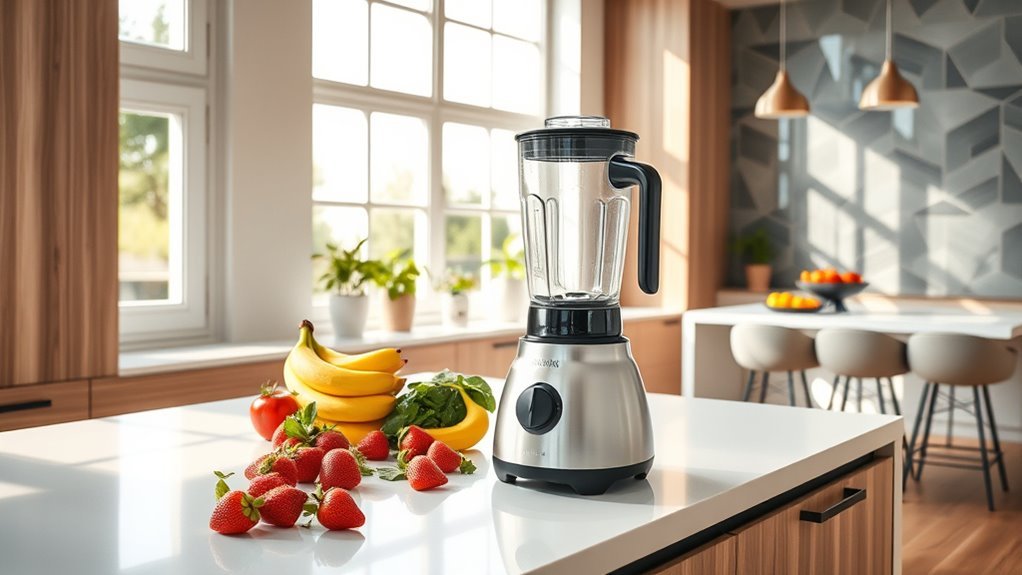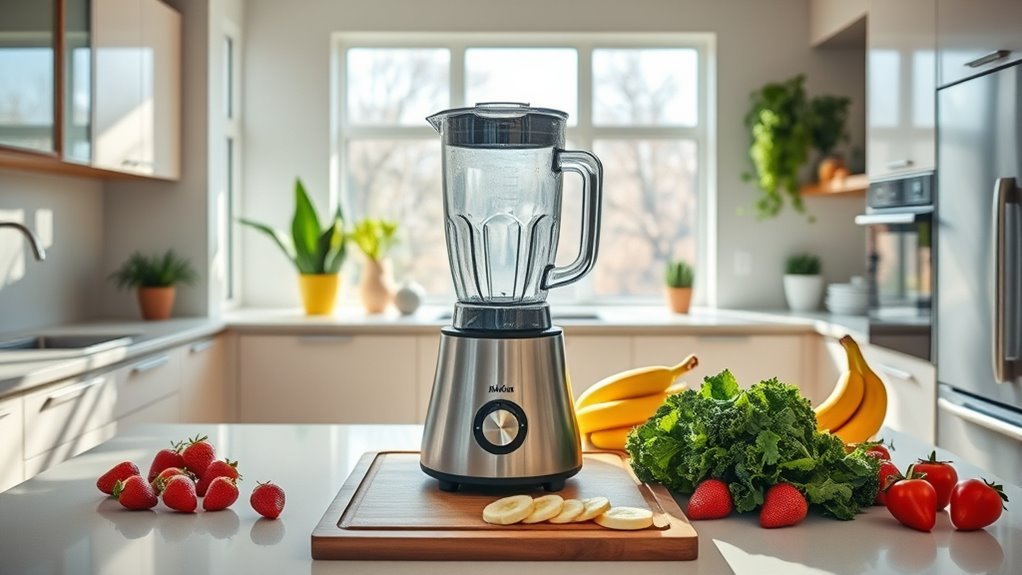We’ll help you zero in on the perfect blender container size for your needs. For single servings, grab a 20-ounce cup that’s perfect for protein shakes and smoothies. Family meals? The 64-ounce container’s your go-to. The 32-ounce sweet spot handles most daily blending tasks, while the 8-ounce bowl tackles tiny batches of dressings and baby food. Consider your counter space too – those 20 and 32-ounce models fit under most cabinets. Let’s explore how each size matches your specific blending goals.
Common Container Size Categories and Applications

Flexibility is the hallmark of modern blending, and container sizes are your secret weapon.
We’ve got your blending needs covered with sizes ranging from massive 64-ounce containers down to compact 8-ounce bowls. Let’s break it down.
For family meals and bulk recipes, grab the 64-ounce powerhouse.
Need something for medium batches? The 48-ounce and 32-ounce containers handle soups and smoothies like pros.
Watch that minimum volume, though – you’ll need at least 12 ounces in that 48-ounce container for proper blending.
Going solo? The 20-ounce cup is your on-the-go buddy for single servings.
And don’t overlook that mighty 8-ounce bowl – it’s perfect for small batches of baby food and dressings.
High-performance blenders are versatile and durable, making them ideal for handling various container sizes effectively.
Size matters, and we’ll help you nail the right choice every time.
Material Selection and Durability Factors
Beyond size considerations, your blender’s material composition determines its long-term performance. We’ll show you why Vitamix’s BPA-free Eastman Tritan Copolyester and non-removable stainless steel blades create the gold standard for durability and safety.
| Feature | Impact |
|---|---|
| Durable Plastic | Withstands high temps without leaching |
| Steel Blades | Non-removable for safety and longevity |
| Tamper Design | Handles thick blends without strain |
| Container Shape | Creates ideal blending vortex |
Smart maintenance extends your container’s lifespan. Avoid extreme temperature changes and clean properly after each use. Remember, these containers aren’t just plastic boxes – they’re engineered systems built for effective, long-term use. The high-quality materials and thoughtful design meet diverse blending needs while maintaining consistent performance standards across all size options. Additionally, investing in high-performance blenders can enhance your blending capabilities and overall kitchen efficiency.
Space-Saving Design Considerations

When kitchen counter space comes at a premium, every inch matters for your blender setup. That’s why we’re seeing a surge in space-saving container designs that optimize both height and blending capacity. The 20-ounce and 32-ounce options sit comfortably under most cabinets at 8 and 9.8 inches tall, respectively.
Let’s talk compatibility – these compact containers aren’t universal. You’ll need to match them with specific blenders designed for space-saving functionality.
The 20-ounce cup, perfect for single-serve smoothies, works with Legacy models through a Personal Cup Adapter. For larger batches without the height, consider the low-profile 64-ounce container. It’s the sweet spot between volume and vertical space.
Remember: your kitchen’s constraints should guide your container choice, but never compromise on blending performance.
Batch Processing Capabilities
Different container sizes reveal distinct batch processing sweet spots that’ll transform your blending game.
We’ll help you match containers to your ingredient volumes for best results.
- 8-oz bowl: Perfect for tiny batches – no minimum volume means ultimate small-batch flexibility
- 20-oz cup: Your go-to for single servings, compatible with protein shakes and smoothies
- 32-oz container: Handles small batches with 8-oz liquid minimum, ideal for everyday blending
- 64-oz tall: Master of large batches, but watch those minimum requirements
Let’s be clear: bigger isn’t always better.
Each container’s processing capabilities serve specific needs.
The 48-oz sweet spot hits that medium-batch balance, while the 8-oz bowl crushes those precise small jobs.
Match your container to your typical batch size – that’s smart blending.
Volume Requirements for Different Recipes

Understanding your recipe’s volume requirements is essential since each blender container demands specific minimum amounts for proper blade engagement. Let’s break down exactly what you’ll need for different batch sizes.
| Container Size | Minimum Volume | Best For | Maximum Capacity |
|---|---|---|---|
| 8-oz Bowl | 2 oz | Baby Food, Dressings | 8 oz |
| 20-oz Cup | 8 oz | Single Servings | 20 oz |
| 32-oz Container | 8 oz liquid/20 oz thick | Small Batches | 32 oz |
| 64-oz Tall | 16 oz | Large Batches | 64 oz |
We’ve found the 32-ounce Vitamix container handles small batches perfectly, while the 48-ounce container excels at medium-sized recipes. For blending large batches, grab the 64-ounce tall container – just watch that cabinet clearance. Single-portion smoothies? The 20-ounce cup’s your go-to. Precise small-batch needs get the 8-ounce bowl treatment.
Performance Impact of Container Dimensions
Container dimensions play an outsized role in your blending success – far beyond just how much they hold.
We’ve found that Vitamix container size directly impacts blending efficiency and your kitchen workflow.
Let’s break down why this matters.
Different containers excel at different tasks:
- 64-ounce containers create powerful vortexes for large batches
- Low-profile designs fit better under kitchen counter cabinets
- 32-ounce containers handle small batches perfectly
- Smaller containers offer superior cleaning ease
The math is simple: larger containers need more ingredients for peak performance.
You’ll need at least 16 ounces in a 48-ounce container, while a 32-ounce container works with just 8 ounces.
It’s not just about capacity – it’s about matching container dimensions to your specific blending needs and kitchen setup.
Cleaning and Maintenance Based on Size
When it comes to cleaning your blender containers, size dramatically impacts maintenance requirements and effort.
Let’s break it down: larger containers like the 64-ounce models need immediate attention and soapy water blending for thorough cleaning. We recommend using a bottle brush to reach those tricky corners.
Smaller containers are your maintenance dream – the 8-ounce bowl practically cleans itself, whether by hand or dishwasher. The 20-ounce cup’s removable blade design makes cleaning a breeze.
Don’t forget, we’ve got to regularly check those seals on all containers to prevent buildup and guarantee peak performance.
It’s simple: bigger containers demand more effort, while smaller ones offer easier cleaning. Choose your container size wisely – your future self will thank you during cleanup time.
Frequently Asked Questions
What Is a Good Size for a Blender?
We’d recommend a 48-ounce blender for versatile meal prep and family use, while 32-ounce models work great for personal smoothies. Consider your serving sizes and storage space when choosing.
Is the 48 Oz Vitamix Big Enough?
We’d say the 48 oz Vitamix hits the sweet spot for most families, offering enough capacity for smoothies and meals while maintaining recipe versatility, easy cleaning, and practical countertop storage.
Can You Put a 64 Oz Container on a Vitamix E310?
Yes, we can confirm the E310 is compatible with both 64-ounce containers. We recommend the Low-Profile version for under-cabinet storage, though both options will blend efficiently on your Legacy series base.
Which Vitamix Fits Under Cabinets?
Like finding the perfect puzzle piece, we recommend the Vitamix models with 32-ounce or 48-ounce containers, standing at 9.8 inches tall, which fit comfortably under most kitchen cabinets.

